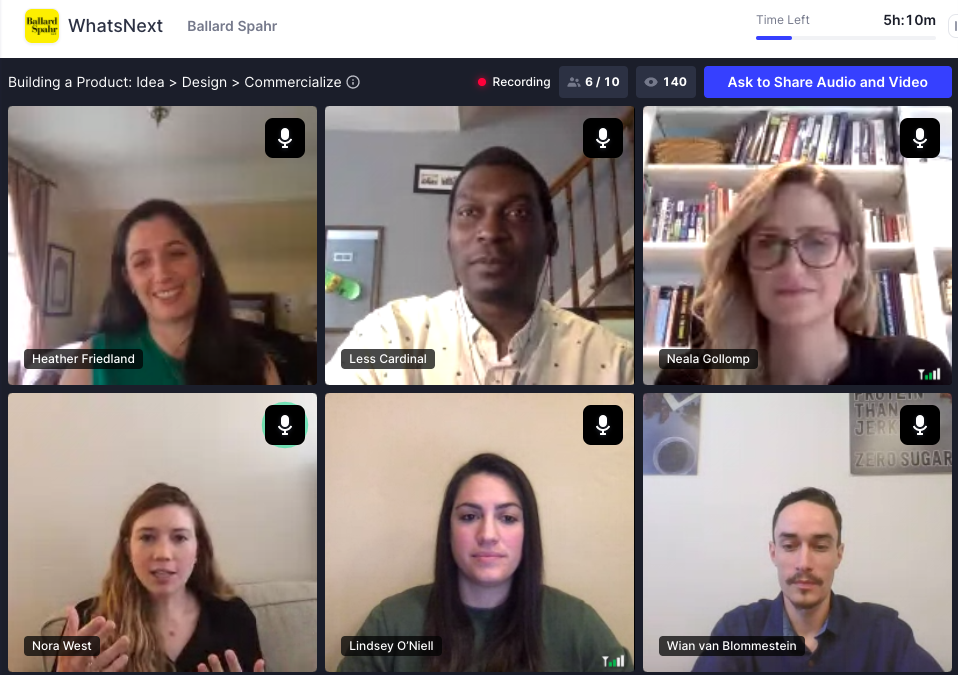Assessing a product’s quality and customer success doesn’t look that different whether you employ thousands, or just five people.
At Ballard Spahr’s What’sNext event on Tuesday, five product professionals and company leaders talked with Technical.ly Product Manger Less Cardinal about how they take ideas through to commercialization.
We heard from folks at a range of companies specializing in telecommunications, genealogy and yes, even beef jerky. While the products themselves range, there are similarities in how the pros refine and improve their product offering, touching on design, interacting with customers and how current events might effect production.
Panelists included Heather Friedland, VP of product management health and wellness at Ancestry.com; Neala Gollomp, senior director of product management at Comcast; Lindsey O’Niell, senior product manager at Crossbeam; Nora West, senior product manager at Guru; and Wian van Blommestein, cofounder of Ayoba-Yo.
Here’s what panelists had to say about bringing product ideas to life:
How do your teams go around product ideation? How do they engage with consumers?
At Crossbeam, O’Niell said, the team has just recently just achieved product market fit. Because the partner ecosystem platform doesn’t really have direct competitors yet, the shifts in product usually come from customer conversations.
“We essentially want to know, ‘How disappointed would you be if this product did not exist?'” O’Niell said. She elaborated that they’re looking for at least 40% of respondents to say the product is essential for them.
Blommestein said that design has become very important to his beef jerky company. His small team is undertaking a deep dive into customer experience and communication this summer and will be assessing their website, Facebook marketing and even the unboxing experience. In the food industry, there’s not always a ton of room for innovation, but “one things that differentiates us is user involvement,” he said.
Gollomp told attendees that her work with Comcast’s X1 feature often revolves around solving a customer problem. The company gets a lot of data — the voice control receives more than a billion commands a month. And the trends in new requests, searches or usage informs how the product is changed over time, she said.
“We hear lots of feedback from customers,” Gollomp said. “That definitely informs future products and features.”
For Friedland at Ancestry, her product aims to include all aspects of an experience you’d have with a genetic counselor. The company has its signature family tree, but is also trying to build out DNA products for customers to learn about where they’re from, as well as the health aspect of genealogy and the connectedness to others.
“The product is trying to take the information from customers and make it into an experience of learning your history,” she said.
Have current events changed how you’re testing or developing products?
West told attendees that Guru has often thought about accessibility when building products, but that they’ve recently been extra aware of things like usability and the different contexts the customer will use the product in. Factors like language, screens with different color variations or different qualities of computer screens will affect how a product is received and used.
“We have to think, ‘What is the world our customer is living in?’ and understand we come from different backgrounds,” she said.
West added that Guru was already remote-friendly, but an entirely remote team and customers have driven them to test products differently. They’re now doing “ride-alongs” with customers who will share their screen and use Guru’s software so developers have a better understanding of how they use it on their own.
Have you ever been in the idea phase and learned something new?
You shouldn’t always assume you know what a customer wants, Gollomp told attendees. The X1 team first assumed customers would want voice features in its app like when using the X1 remote. But after a proof of concept, the data showed that people just weren’t using the feature much. It boiled down to the offering not being up to par with what customers would have wanted, she said.
“In order to do it fast, it actually hindered our ability to test well, and not many customers were able to find it,” Gollomp said.
Guru’s also earned a lot about discoverability when rolling out new features, West said. Essentially, you can build the easiest to use, most awesome tool, but if it’s not clear how to use it or where to find it on your site, it’s useless.
“If it’s not in their workflow or easily accessible, it’s just not viable for them,” she said.
Join the conversation!
Find news, events, jobs and people who share your interests on Technical.ly's open community Slack

Philly daily roundup: Student-made college cost app; Central High is robotics world champ; Internet subsidy expiration looms

Philly daily roundup: Earth Day glossary; Gen AI's energy cost; Biotech incubator in Horsham

Philly daily roundup: Women's health startup wins pitch; $204M for internet access; 'GamingWalls' for sports venues


